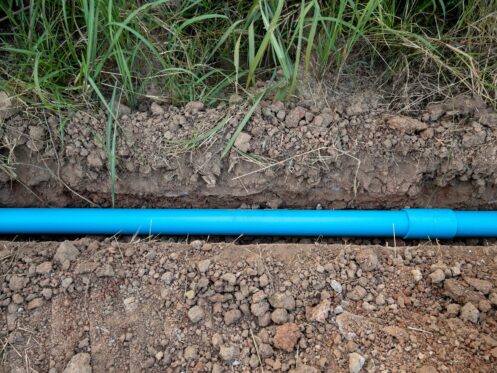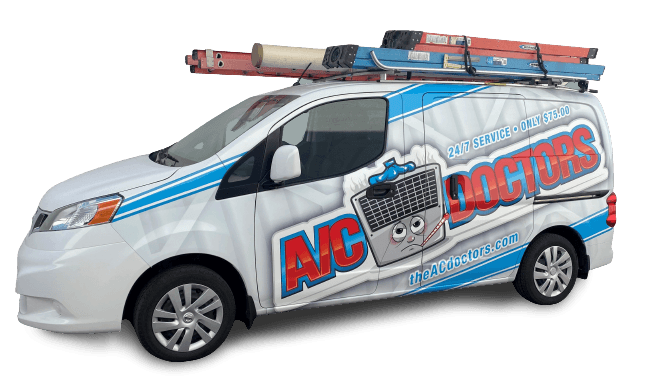All drains in your Gilbert, AZ home converge onto your sewer line. This lone pipe carries your wastewater and solid waste away from the building and to the municipal sewer main. When your sewer line develops cracks, offset sections, or blockages, scheduling timely sewer repairs can limit property damage. Fortunately, there are ways to know when your sewer line needs a repair.
Regular Sewer Line Inspection and Cleaning Services
The best way to stay abreast of your sewer pipe’s age and integrity is by scheduling regular sewer line inspection and cleaning services. Most plumbers recommend scheduling these services every 18 to 22 months.
During these visits, plumbers use sewer line cameras and other non-invasive diagnostic tools to survey the interior of sewer pipes. They look for intrusive tree roots, trapped sediment, and more. They also assess the age of sewer pipes and estimate their remaining lifespans. This way, homeowners can plan for essential sewer line replacements before these pipes fail outright.
Sewer line cleaning flushes out heavy buildups of hard water minerals, trapped, slow-degrading debris, dangerous biofilms, and invasive tree roots. Plumbers can use hydro-jetting, hydro-steaming, or rooter machines to leave pipe interiors open and pristine.
Sewer cleaning extends the lifespan of sewer pipes by eliminating heavy buildups and partial blockages. Sewer line inspections allow plumbers to make timely interventions so that developing problems never have the chance to escalate. Before professional plumbers enter the picture, though, there are 9 ways to know when you should schedule sewer line repair services.
1. Rank Sewer Gas Odors
Sewer gas smells like rotten eggs or rotten cabbage. Water-filled P-traps at each drain in your home block sewer gases from entering the building. If you smell sewer gas near your kitchen or bathroom sink, you may have a dry P-trap. However, if all your drains smell like sewer gas, this could be a sign of an impending whole-house backup.
Whole-house backups occur when sewer line obstructions prevent effluent from exiting the sewer line. If residents continue using your plumbing system, trapped waste will come back into your home. Whole-house backups send raw sewage into all plumbing-connected appliances, wastewater pipes, and drains. They expose building residents to dangerous biological and chemical contaminants, and they can cause tremendous property damage.
Sewer Gas From a Cracked Sewer Pipe
You should also be leery of sewer gas odors in your basement, crawlspaces, and other low-lying areas. These smells could mean that the portion of your sewer line that travels beneath your home’s slab has a leak. Whether due to offset pipe sections, soil shifting, or age-related cracks, sewer leaks that occur beneath slabs can undermine the integrity of homes from their foundation to their roofs.
Cracked sewer pipes can also emit strong sewer gas odors outdoors. If you smell sewer gas in areas just above the underground portion of your sewer pipe, call a plumber right away.
2. Stubborn Pest Problems
Cracked sewer pipes create viable points of ingress for mice, rats, and other small-sized animals. The wastewater and nutrient-dense effluence that flows from damaged sewer pipes can also attract flies, ants, and cockroaches.
Sewer line damage outside the building could create the perfect conditions for drain gnats indoors. Drain gnats breed in dirty, slow-moving drains. Trapped moisture and waste create favorable conditions for their larvae.
Whether dealing with a stubborn rodent infestation or six-legged critters, repairing your sewer line could be a critical step in pest treatment. Fixing a cracked or offset sewer pipe will make your home less appealing and less accessible to these unwanted guests.
3. Rapid Lawn Growth
If your lawn suddenly appears far greener and healthier than it ever has before, you may need a sewer line repair. The excess moisture and nutrient-rich contents that seep out of sewer pipes serve as a powerful, localized fertilizer. Unfortunately, sewer line leaks also cause dangerous soil contamination that can affect your landscape and the soils on neighboring properties.
4. Pooling Water and Muddy Terrain
Inspect the areas just above your sewer pipe. Is it sodden and sunken or perpetually muddy? Pooling water that never dries is a common sign of sewer pipe leaks. As soon as pooling water evaporates, wastewater from continued plumbing use replaces it.
5. Multi-Drain Issues
Almost every home has a dirty, clogged, or slow-moving drain at some point in time. Single-drain clogs are common and often easy to resolve. However, if every drain in your home starts moving slowly, emitting foul odors, or clogging at once, you have a whole-house backup on the way.
Recurring drain clogs can also indicate sewer line troubles. You might have a partial sewer line blockage that allows liquid waste and soft, semi-solid materials to pass. This is frequently the case when tree or weed roots encroach upon sewer lines. Invasive roots grow in tight, concentric coils or long, ropy lines that snag undissolved paper products and human waste, but allow liquid effluence through.
6. Noisy Drains
Do your drains make loud gurgling or sucking sounds? You’ll likely hear these noises long after people have stopped using your plumbing system. Just as you’re drifting off to sleep, you might hear bubbling noises coming from your toilets. These sounds occur as trapped waste gradually clears partial sewer line blockages. If you schedule sewer line service as soon as you hear them, you may be able to prevent a whole-house backup.
7. Foundation Cracks
If you have a sewer line leak beneath your home’s slab, you’ll eventually see cracks in the foundation. Sewer line leaks destabilize the soils beneath homes and cause them to shift and settle. This creates fast-expanding voids beneath buildings and places extreme stress on foundations.
If left unchecked, leak-related changes in soil stability could lead to drywall and ceiling cracks throughout buildings. As homes shift, sewer line leaks can cause separation at roof valleys and loose roof flashing.
8. Rising Humidity
Wherever there’s a leaky or clogged pipe, there’s bound to be excess moisture. Trapped water in slow-moving and clogged drains will evaporate and enter your indoor air. If your home constantly feels muggy or clammy, sewer line damage is a likely reason why. When paired with pungent sewer gas odors, increased humidity could make being indoors intolerable.
9. Changes in Your Indoor Air Quality
According to the U.S. Environmental Protection Agency (EPA), when indoor humidity rises above 60%, mold spores can form. As per the U.S. Centers for Disease Control (CDC), it takes just 48 hours for a leak or flood-related mold infestation to start. If dank, moldering odors join rank sewer gases, you likely have a sewer line issue.
If you have a smart thermostat, this device could send out an indoor air quality (IAQ) alert following a mold infestation. When sewer line problems exist beneath residential slabs, they can also allow radon, methane, and volatile organic compounds (VOCs) into the building. High concentrations of these gaseous chemical contaminants can trigger smart thermostat IAQ alerts as well.
As a family-owned and -operated company, A/C & Plumbing Doctors has proudly served Gilbert and the surrounding communities for over 20 years. We offer expert drain cleaning and sewer services, including trenchless sewer replacement. If you have a blocked or leaky sewer line, contact A/C & Plumbing Doctors today to schedule an appointment.





